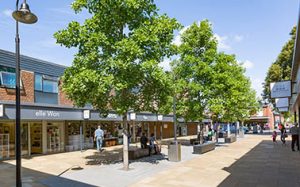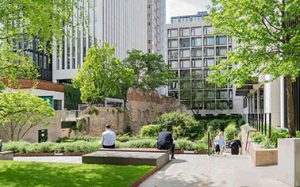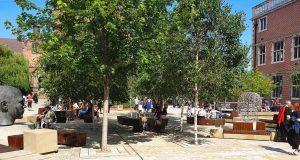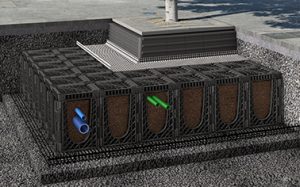We all know the benefits that trees can bring to our planet. Not only do they look great, but they also help in our fight against climate change with a single mature tree removing around 24.6kg of carbon per year and providing enough oxygen for two people.
Did you know, however, that they can also be used as part of your surface water drainage strategy?
This week as part of our deep dive into the world of Sustainable Drainage Systems I caught up with Louise Page, Hannah Cook and Howard Gray from GreenBlue Urban. For those of you that have not come across this fabulous company, they have over 28 years of experience in urban tree planting and pride themselves on being the industry experts in establishing the future of urban landscape through green-blue infrastructure.
Together we discussed what you should be considering when thinking about incorporating a tree pit as part of your development, how they can benefit your surface water design before finally busting some common myths.
Figure 1: Example of Tree pits installed on St Martins Precinct

Source: GreenBlue Urban Case Studies (https://greenblue.com/gb/)
What do I need to consider when thinking about using trees on my project?
Like most living things, some basics will need to be considered when siting a tree on your project to ensure that it does not just survive but thrives. In summary, you will need to make sure that your tree has access to:
- Sufficient space
- Appropriate soil
- Sufficient gas exchange
- Drainage; and
- A good supply of water.
While this may seem basic, failing to get this right can result in increased costs, either through a requirement for additional support for the tree or in the worst-case replacement of the tree entirely.
When we are looking at using trees as a SuDS components, particularly in urban environments, the main risk can be in association with soil compaction from vehicles which can limit the access of the roots to both air and water.
As such it is always worth spending a bit of time thinking about where you want to add trees into your development and ensure that they are incorporated into the design early so the above can be catered for.
What are the benefits of using tree pits on my site?
There are many benefits of using trees and tree pits on your site, with the most obvious being that they look great and it has also been proven that trees and green space can have a positive impact on both health and wellbeing.
Like with some of the other SuDS components we have looked at they are also brilliant at removing pollutants and are particularly effective adjacent to roads as they can remove up to 60% of exhaust fumes.
Howard Gray also highlighted these additional benefits which could be particularly useful for developers:
“As you are aware, trees provide multiple benefits on new developments, but the most compelling one to developers is the added value to building plots. The average uplift in plot value is 15% which can increase the profit margin dramatically. In addition, tree planting provision can speed up planning permission, which is desirable in many situations.
With the Environment Bill going through Parliament, Nett Bio-Diversity Gain will be a strong lever to plant trees on developments, as mature trees host vast numbers of animal, insect and plant life.”
Figure 2: London Wall Place

Source: GreenBlue Urban (https://greenblue.com/gb/)
So, how can trees and tree pits be used in surface water drainage design?
The first thing to consider when thinking about using a tree as part of your drainage strategy is that it is not going to be your main source of attenuation. Tree pits are only really intended to manage small catchment areas, like what you would expect a typical gully to drain. As such, it is best to use them in combination with some of the other systems we have discussed as part of this series.
The main ways that trees manage surface water is as follows:
- Canopy interception – If you have ever sheltered under a tree during a storm you will have seen this in action. The canopy, branches and trunk of the tree intercepts and absorbs rainfall which reduces the amount of water that reaches the ground.
- Evapotranspiration – this is the process of water being drawn up through the vascular system and evaporated through the leaf surface, amazingly this can equate to hundreds of litres per day.
- Infiltration – This is where water is permitted to travel down the surface of the tree roots. Tree roots can be extensive and are generally a minimum of 1m deep which can therefore also provide opportunities to recharge the groundwater.
Back to Howard from GreenBlue who also had this to add with relation to how the soil surrounding the trees can also be used for surface water management:
“The soil itself can attenuate water: uncompacted forest floor soil is at least 40% air by volume, this means that water can remain in the soil for a while. When GreenBlue Urban calculates stormwater attenuation volumes, we allow a conservative 20-25% of soil volume for stormwater storage. In practical experience, we find that in a storm event, the tree pit can become completely saturated for up to 48 hours without any damage to the tree. Anaerobic conditions are created by saturation for 72 hours; therefore you should always calculate for full drainage within 24 hours, giving at least 100% additional storage for exceedance flow.”
Do they require a lot of maintenance?
Generally, trees will require the greatest amount of maintenance during the first few years when they are establishing. This can include activities such as the removal of litter, debris and invasive species, irrigation during any prolonged dry periods and the inspection of any inlet and outlet structures.
Less frequent maintenance can include periodic inspections to determine the health of the tree as well as any pruning.
It should be noted that to ensure the tree has the best chance any maintenance responsibilities should be placed with an appropriate specialist such as an arboriculturist/ landscape architect.
Figure 3: Newcastle University

Source: GreenBlue Urban (https://greenblue.com/gb/)
Three common myths busted!
As we have seen, there are many benefits to incorporating trees into your development, however, as a designer, I still often get clients who have some real concerns when we start looking at the possibility of including them within their designs.
These are usually concerning how they are going to interact with any structures, hardstanding and utilities. To try and get to the bottom of this I asked Howard what the three most common myths were associated with tree pits.
Myth 1: Trees can not be planted near properties as they will cause subsidence
Not true. The natural geological makeup of shrinkable clay soils can mean that where trees are planted close to properties, deeper foundations may be required, or that some root management protection should be installed. NHBC guidance is currently being revised to allow more tree types.
Myth 2: Trees in highways won’t be adopted if they are planted in a cellular soil system.
Not true. Whilst a few highways authorities are still stuck in the past, most are prepared to adopt engineered tree pits – but may still charge a hefty commuted sum to adopt.
Myth 3: You cannot plant trees on many developments due to too many utility runs.
Not true – almost every project that GreenBlue Urban works on, have these below-ground constraints, and we have become highly experienced in finding solutions and compromises to these issues. Often, using tree root management and root baiting, trees can be planted and become established in zones which might have been outbounds historically.
Figure 4: Example of tree pit and utilities run

Source: GreenBlue Urban (https://greenblue.com/gb/)
Summary
As we have seen, trees can bring a whole host of benefits as well as contribute to the management of stormwater on your development.
If you want to know why not check out some of the fabulous resources kindly supplied by Hannah, Howard and Louise or, check out GreenBlue Urban’s brilliant podcast series ‘Trees-Stormwater’ which can be found on all major streaming platforms.
- GreenBlue Urban Website – https://greenblue.com/gb/
- Publication – Trees and Water Sensitive Urban Design
- Publication – Street Tree Cost Benefit Analysis
- Webinar Series & Refresher Pack Request
- Case Studies